According to Ahrefs, 91% of web content does not drive organic traffic from Google.
That’s surprising.
We also know that content marketing makes up the highest budget share for SEO experts.
This means that a large portion of your content creator’s work may not be driving organic search traffic to your site.
This stat leaves many businesses wondering:
- How can I make sure my content generates organically-driven traffic from Google?
- What steps can I take to shift my SEO team’s time-spend into other areas that move the needle?
Answer: By using AI.
AI can automate the most time-consuming tasks in content creation, such as content gap research and content brief creation. Automation has the potential to effectively free up your team’s bandwidth and prioritize more important optimization tasks.
This is why we created Semji.
Our solution helps SEO and marketing teams produce higher-performing content in less time.
Here are four content creation tasks you can automate today for a faster team, more success, and a higher profit margin.
Task 1: Automate Your Top-Content Prioritization Strategy
When launching a content strategy, one of the first considerations is where to focus your efforts for increased SEO performance.
Automation can help you quickly discover which content pieces to prioritize and how to pivot your strategy for better results.
Automatically Get A Priority Score For Each Piece Of Content
Which content pieces should remain published? What should you optimize? Where should you get started?
It’s not always easy to identify top priorities when creating a content refresh strategy — especially when your website has hundreds or even thousands of pages.
Luckily, proven auditing techniques exist – like our dedicated flow chart, which gives you hints on what to prioritize in your content revision process.
The Problem
Performing a manual audit to identify content gaps is a lengthy process that could lead to time wasted if the wrong pieces of content are refreshed.
The Solution
Automated solutions like Semji use unbiased data to instantly identify the right pieces of high-potential content. With Semji, you can prioritize your content optimization plan by what truly impacts ROI.
How does it work? Right after creating your account, the platform instantly lists your website’s content by the highest potential for improved performance.
With the help of AI technology, Semji scans your entire website, processes the data from your analytics tools (such as Google Analytics, Google Search Console, and AT Internet), and assigns a priority score to each piece of content.
With this priority score, you can quickly see which content requires the least optimization work to bring in the highest ROI.
 Screenshot from Semji, Pages Module, November 2021
Screenshot from Semji, Pages Module, November 2021Automatically Target Top-Priority Queries To Inform Your Strategy
All good SEO strategies start with identifying the right queries to target.
Depending on your objectives, you may need to identify several different types of queries to reach your individual goals.
For example, if one segment of your strategic goal is to increase brand awareness, you would need to target generic keywords.
If a separate goal is to increase conversions, you would need to also target long-tail keywords in your overall strategy.
 Source: Semji, Short tail vs. Long-tail keywords
Source: Semji, Short tail vs. Long-tail keywordsThe Problem
As you build out your strategy, you will discover that your target audience might make dozens of different requests to express the same need.
This leads to the essential but time-consuming step: determining which high-priority keywords to focus on. If the wrong keywords are selected, you may see a decrease in ROI.
The Solution
With automation and Semji, your SEO and content strategy is built on strategic queries based on keyword themes. This type of strategy effectively prepares your website for Google’s MUM algorithm.
Semji removes the tedious research step and provides ideas for keywords and questions that will give you the highest traffic potential.
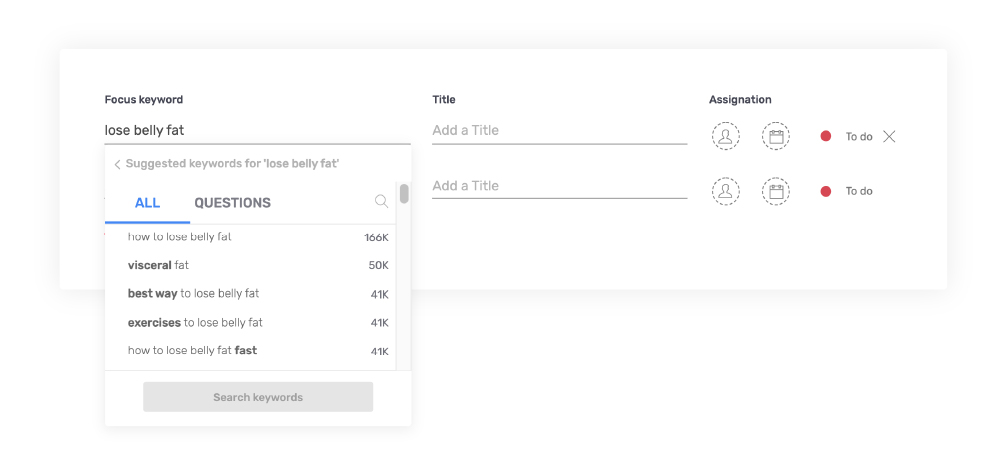 Screenshot from Semji, Suggested Keywords, November 2021
Screenshot from Semji, Suggested Keywords, November 2021For instance, for the query [lose belly fat], Semji provides several complimentary keywords such as [how to lose belly fat], [best way to lose belly fat], or [exercises to lose belly fat].
With Semji, you’ll see exactly which queries generate high search volume, and you’ll discover new opportunities you may not have thought of.
Task 2: Automate Competitor Analysis
Competitor analysis is essential for two reasons. It helps you:
- Identify the strengths/weaknesses of your competitors.
- Get to know your audience’s and Google’s expectations of your targeted topic.
With new players entering the space every day and regular updates from Google, competitor analysis requires constant monitoring.
Automation can help you centralize your competitor’s content and quickly find new opportunities to boost your SEO performance and win market shares.
Easily See The Structure Of Competing Content
Visualizing the structure of competing content allows you to analyze how top performers cover topics and what content Google favors.
It also means knowing what online users expect, or what the search intent behind their query is, based on the search engine results page (SERP).
In the end, it comes down to understanding the intent behind the SERP in order to know exactly what content to create.
The Problem
Manually researching competitors’ content takes a lot of time, and bad analysis of competitor content creates the risk of missing the mark.
You may spend time on a piece of content that brings in zero visitors.
The Solution
With Semji, you can see the ten best-performing content pieces on Google seconds. In one click, you can easily identify which topics to add to your content strategy.
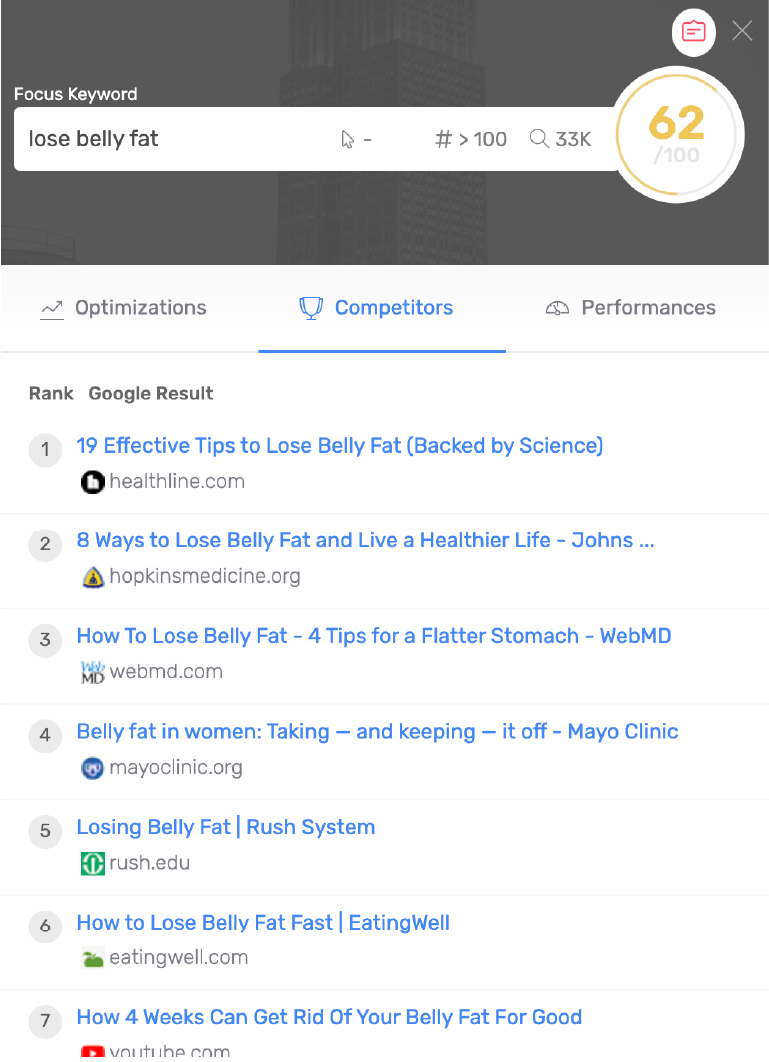 Screenshot from Semji, Competitors Tab, November 2021
Screenshot from Semji, Competitors Tab, November 2021Automatically Find Out Which Topics Are Saturated And Fill In The Gaps
To make sure you produce content that will drive more traffic and ROI, you need to make sure your audience is interested and that your content matches their needs and search intent.
There are thousands of websites serving content that answer your audience’s query. It’s up to you to provide the best answer.
The Problem
The competitor research required to know what topics have been covered and where gaps exist takes time.
Analyzing and making decisions on which approach you should take in your content also takes time.
Poor analysis could lead to time spent on an off-topic article that returns zero traffic.
The Solution
Automating topic gap research will help you capture the attention of your audience and Google.
Using AI, Semji’s heatmaps can help you immediately identify content wins.
These can show you the search intent of potential customers, topics covered in the top-ranking content, and areas that are unanswered by your competitors.
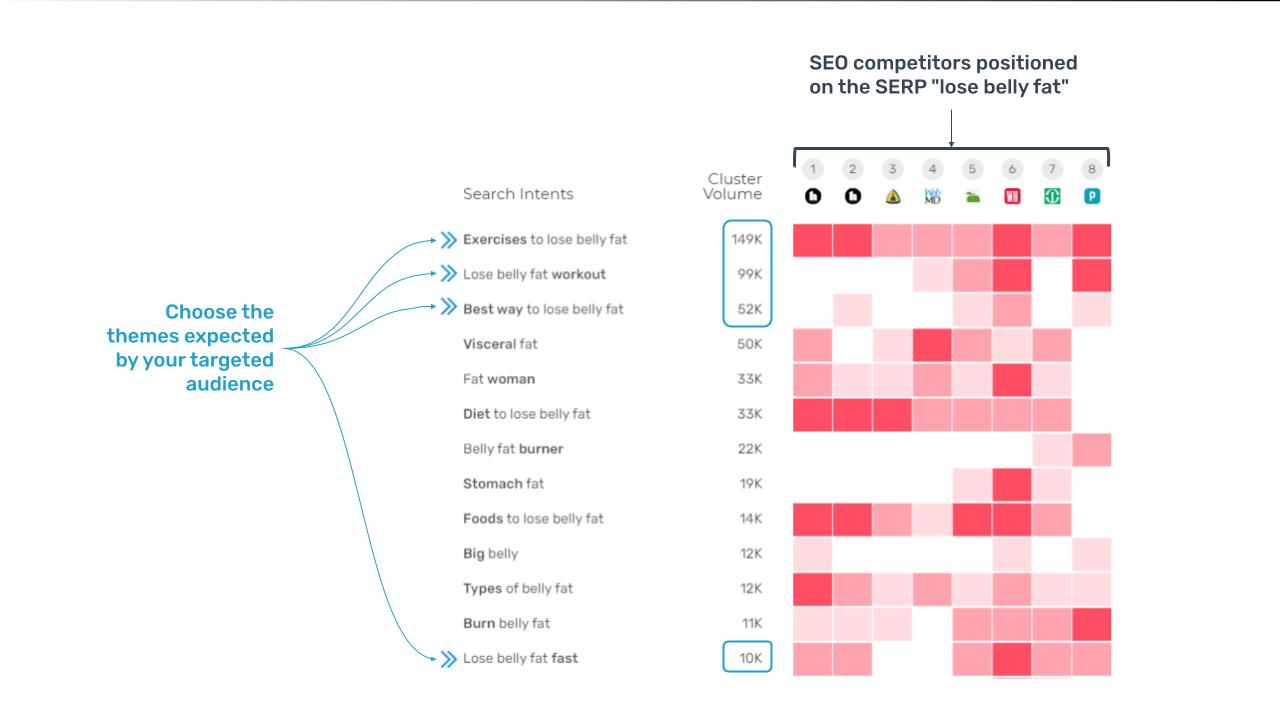 Screenshot from Semji, Search Intents heatmap, November 2021
Screenshot from Semji, Search Intents heatmap, November 2021In the example above, Semji shows that for the query [lose belly fat], online users are most interested in finding [exercises] to get rid of belly fat (+300k searches on this topic).
A subject that is extensively covered by all the competitors on the page (dark pink) is an essential topic to cover.
However, a topic that has not been covered much (white, light pink box), is a differentiating topic that can also be used to boost traffic to your site.
Task 3: Automate Optimized Content Creation For Google And Your Audience
While there are SEO guidelines for optimizing content, not all copywriters follow these rules. In this scenario, content briefs can help keep your team aligned.
SEO professionals know that the most important step is to create brief templates at the beginning of your strategy. This template should include:
- The list of keywords.
- The expected format.
- The purpose of your article.
- Useful resource links for writers to stay up-to-date.
A good SEO team spends three to four hours on each brief. Automating your brief creation can help you cut this time in half!
Generate Automated And Relevant Content Briefs
Designing a content plan and finding the right content direction is essential for a writer; this can sometimes be time-consuming.
The Problem
On average, producing a piece of content requires a combination of 75% of time spent on preparation and 25% on writing time.
This preparation time could be better spent on tasks that move the needle.
The Solution
Semji relies on GPT-3‘s AI to allow SEO professionals to quickly generate a complete content plan.
Example: You want to work on the query [lose belly fat] and you want your content to focus on the right physical exercises targeting this question.
Thanks to GPT-3, and based on Semji’s Search Intents recommendations, you can easily generate the title of your content:
 Screenshot from Semji, Brief GPT-3, November 2021
Screenshot from Semji, Brief GPT-3, November 2021You can also get suggestions for subtitles:
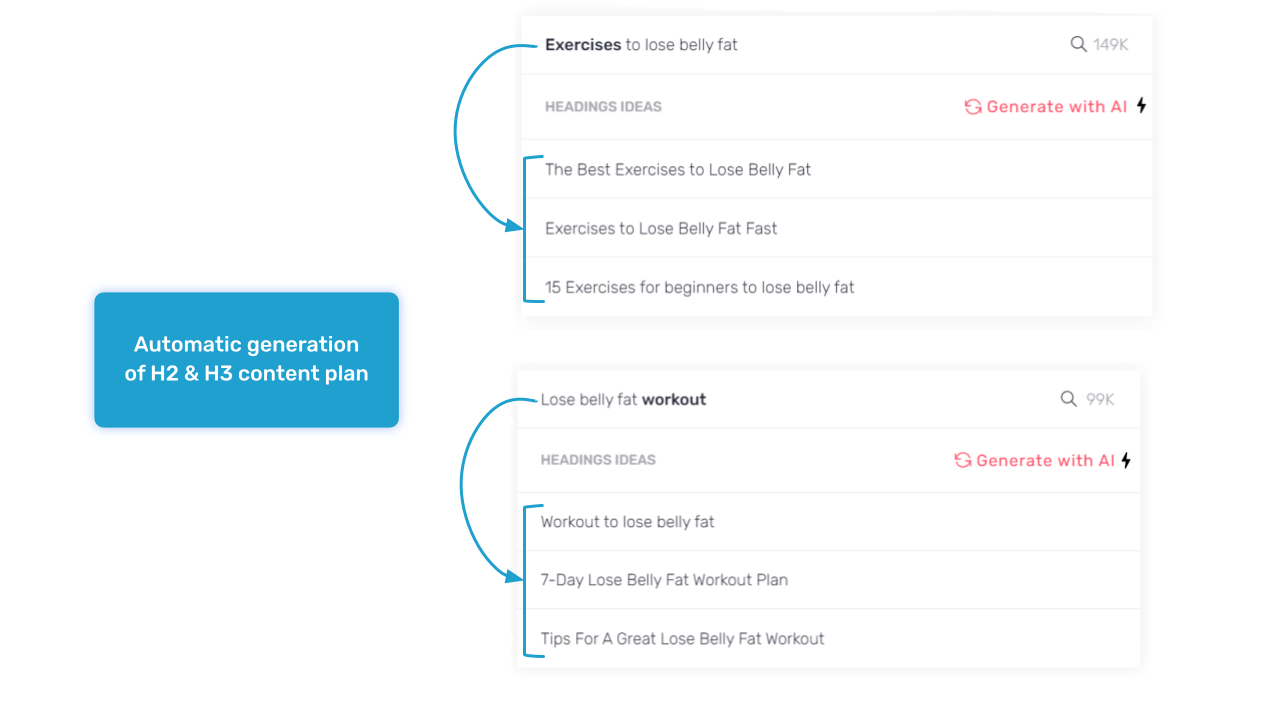 Screenshot from Semji, Content Plan Automatic Generation, November 2021
Screenshot from Semji, Content Plan Automatic Generation, November 2021You can see the “People Also Ask ” listed by Google and suggestions for answers you could provide.
 Screenshot from Semji, Questions and Automatic Answers, November 2021
Screenshot from Semji, Questions and Automatic Answers, November 2021As AI is an ever-changing field, Semji is able to automatically generate text for each paragraph based on the topic covered in the header tag.
 Screenshot from Semji, Content Generation, November 2021
Screenshot from Semji, Content Generation, November 2021Writers remain in control of their content at all times. AI and automation are there to help them increase their performance.
Automatically Get Content Scores To Audit The SEO Quality Of Your Content
To check the quality of your website’s content, we recommend setting up a quality checklist.
Your checklist should include, but not be limited to:
- A compelling title.
- A minimum text length.
- A plan (with header tags) that meets search intent.
- The addressing of all the themes related to the query.
- Answers to the questions of online users.
- A strong mesh between your pages.
The Problem
Auditing individual pieces of content and calculating a quality score can take time.
The Solution
With Semji, this assessment is automatically calculated and represented by a Content Score. This content score is a number out of 100, indicating the page’s level of optimization.
Now, your only goal is to reach a Content Score of at least 80, which is easy to do by simply following the SEO suggestions given to your team by Semji.
Completing each suggestion will increase the Content Score, ensuring that your content is 100% relevant. With a Semji free trial, you can start assessing the SEO quality of your pages today.
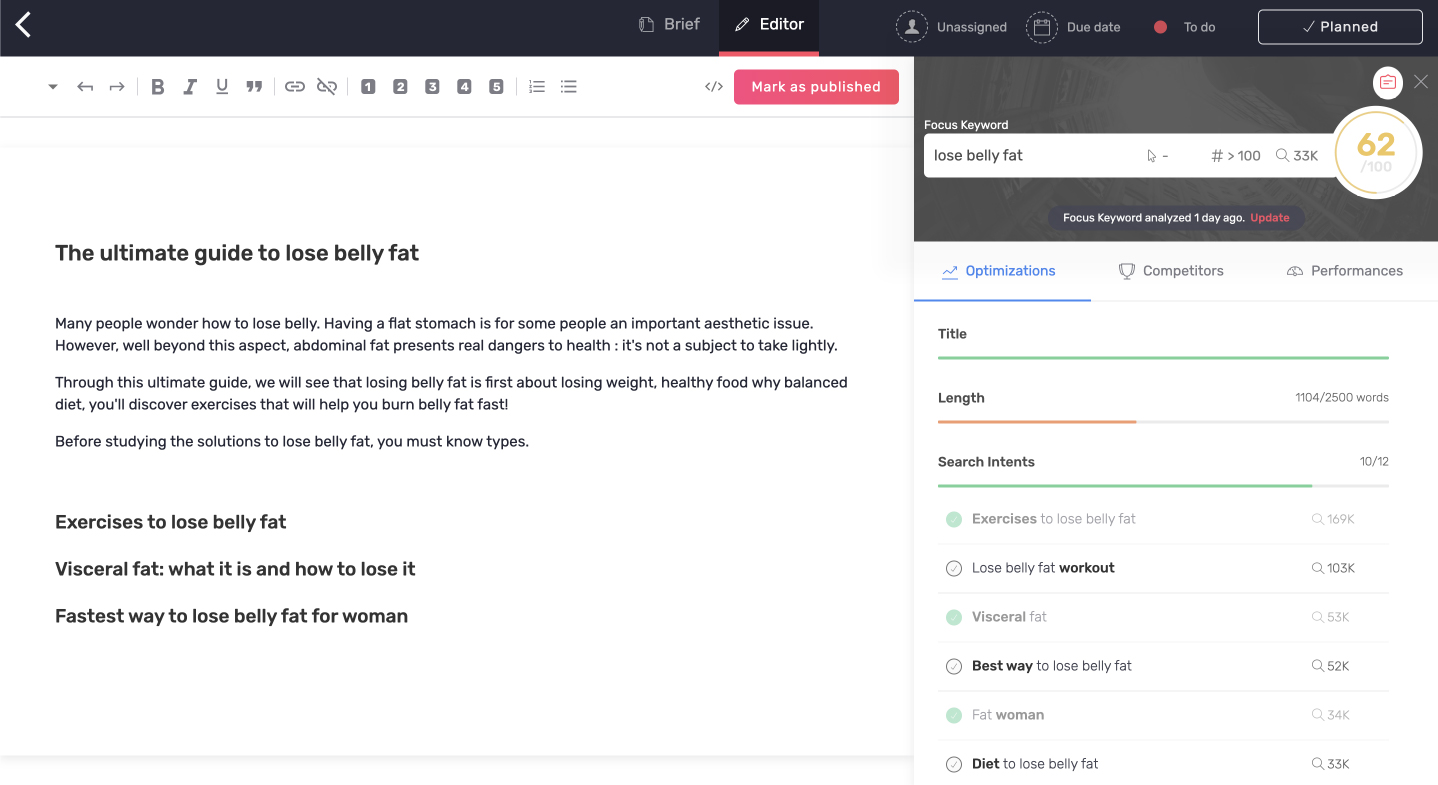 Screenshot from Semji, Editor Module, November 2021
Screenshot from Semji, Editor Module, November 2021Task 4: Automate Your ROI Tracking
Tracking the impact of content marketing remains one of the biggest challenges for marketing departments. In fact, 68% of B2C marketers in 2019 do not know how to assess ROI nor the relevance of their content.
Knowing how to track your ROI is the key to ensuring that your content strategy is working.
Every marketing team should focus on tracking the:
- Progress of your content production (macro view).
- Performance of the content created and updated with business-relevant KPIs (micro view).
Automation will help you see, at a glance, how your content creation is performing in real-time.
Get All Your Data On One Single Dashboard
The Problem
Using several tools to track your KPIs and assess the efficacy of your strategy is complicated to manage. You can quickly get lost in the data.
The Solution
Semji’s Reports feature allows you to automatically track the performance of the content created by your team all in one place.
Semji tracks the different KPIs of your content by collecting data from your Google Analytics and Search Console accounts.
Depending on your objectives and your industry, you can choose the most relevant metrics and track the impact of the content created and optimized with Semji.
Examples of KPIs monitored based on your business targets are:
- E-commerce: sales, transactions, transaction rates, and customized conversion objectives.
- Content visibility: clicks, impressions, and CTR.
- User behavior: average session duration, bounce rate, and pages/session.
 Screenshot from Semji, Reports Module, November 2021
Screenshot from Semji, Reports Module, November 2021Automatically Monitor The Impact Of Individual Pieces Of Content
The Problem
Analyzing how individually-optimized content pieces are performing in order to pivot your strategy is often time-consuming.
The Solution
Semji enables you to view the performance of a single piece of content in a few clicks.
You can set the data to refresh automatically or you can manually refresh it at any time to learn the efficacy of your content. This allows you to continuously monitor the changes in performance.
 Screenshot from Semji, Performances Tab, November 2021
Screenshot from Semji, Performances Tab, November 2021By automating content production tasks, you save time, deliver better content, and, most importantly, increase your SEO performance.
Your free trial of Semji is specifically designed to help you maximize the ROI of your content through AI and automation, saving time and improving your output.
Get more SEO traffic, conversions, and revenue
by optimizing your website content with Semji
The opinions expressed in this article are the sponsor's own.



